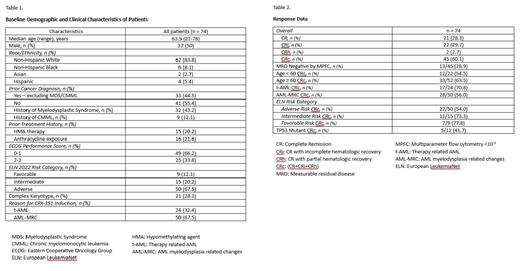Introduction:
CPX-351 is a dual-drug liposomal encapsulation of daunorubicin and cytarabine with a fixed molar ratio of 1:5. CPX-351 is approved for the treatment of newly diagnosed, therapy-related acute myeloid leukemia (t-AML) or AML with myelodysplasia related changes (AML-MRC) in the U.S. and Europe for adult patients (pts) eligible for intensive chemotherapy. In a randomized phase 3 study of older pts ages 60-75, CPX-351 induction showed improved CR rates and OS compared to conventional 7+3 induction, with the greatest benefit seen in pts with t-AML and those without prior hypomethylating agent (HMA) use. There is limited data on the use of CPX-351 in younger pts, although the U.S. FDA approval was not age-restricted. This study examined real-world CPX-351 usage, including patient selection, clinical outcomes, and complications during induction hospitalizations.
Methods:
We identified previously untreated AML pts who received CPX-351 induction chemotherapy at the University of Kansas Medical Center via retrospective chart review from August 2017 - May 2023. Determination of t-AML and AML-MRC was made by patient history, bone marrow morphology, and available cytogenetic and molecular information at the time of therapy selection. We excluded pts who received CPX-351 as part of a clinical trial. Data was collected for baseline demographics, disease characteristics, outcomes, and safety profile. The composite complete remission rate (CRc) was defined as CR+CRi+CRh at recovery marrow after induction. Primary refractory disease included pts who failed to achieve CR, CRi, or CRh after 2 courses of intensive induction and excluded those who died in aplasia or due to an indeterminate cause.
Results:
74 pts with previously untreated AML who received CPX-351 were identified. Median age was 64 years (21-78): 29% of pts were <60 years old, 50% were males, 84% were Non-Hispanic White, 32% had t-AML, 68% had AML-MRC, 20% had prior HMA treatment, and 22% had prior anthracycline exposure. ELN 2022 risk categories were 13% favorable, 20% intermediate, and 68% adverse. 21 pts had complex karyotype (28%), and 16% were TP53 mutant (Table 1).
Indications for induction with CPX-351 versus 7+3 included history of prior chemotherapy (n=24), prior MDS (n=32), or MDS-related changes in bone marrow morphology (n=50).
The CRc for the total study population was 61% (45/74). Of these, 29% (13/45) achieved MRD negativity by multiparameter flow cytometry <10 -4. CRc in the ELN adverse risk group was 54% (27/50), 73% (11/15) in the intermediate-risk group, and 78% (7/9) in the favorable risk group. Among TP53 mutant pts, CRc was 42% (5/12). CRc in the t-AML group was 71% (17/24), 56% (28/50) in the AML-MRC group, and 53% (8/15) in the prior HMA treatment group. The CRc in pts ≥60 was 63%, 15% were primary refractory, and 37% underwent alloSCT in CR1. In pts <60, the CRc was 54%, 32% were primary refractory, and 27% underwent an alloSCT in CR1 (Table 2).
A second course of induction therapy was given for persistent disease at day 14 or similar time point in 36% (n=27) of pts. Among those, 55% (15/27) had primary refractory disease, 20% of the cohort.
At a median follow-up of 11 mos, the mOS was 10.8 mos (0.4-54). The mOS for t-AML was 13 mos, whereas the mOS for the group with prior HMA treatment was 10.4 mos. For pts that achieved CR, mOS was 13.6 mos; for pts that achieved MRD negativity, mOS was 13.8 mos. The mOS for pts <60 was 16 mos, and for pts ≥60 was 10 mos (p=0.39). The mOS for pts that achieved CRc in the group <60 was 20.3mos, and for ≥60 was 11.2 mos (p=0.27). Pts that underwent alloSCT in CR1 <60 had mOS of 25 mos; for ≥60, it was 14.2 mos (p=0.37).
During induction hospitalization, febrile neutropenia was the most common adverse event in 84% (n=62). ICU treatment was required in 14% (N=5). There were 2 deaths during induction: one due to respiratory failure and one attributed to sepsis.
Conclusion:
The use of CPX-351 demonstrated efficacy across subgroups, especially in t-AML and pts without prior HMA exposure, as shown in larger studies. In pts <60 years, even though CRc rates were lower, CPX-351 led to longer mOS in those who achieved CRc and in those who underwent alloSCT compared to pts ≥60 years, although it didn't reach statistical significance in this small cohort. Induction therapy outcomes and treatment-related complications in our study corroborate the data for prior CPX-351 studies.
Disclosures
Lin:Bio-path Holdings: Consultancy, Research Funding; Astellas Pharma: Consultancy, Research Funding; Celyad: Research Funding; Aptevo Therapeutics: Research Funding; Cleave Biosciences: Research Funding; Ciclomed: Research Funding; Jazz Pharmaceuticals: Research Funding.


This feature is available to Subscribers Only
Sign In or Create an Account Close Modal